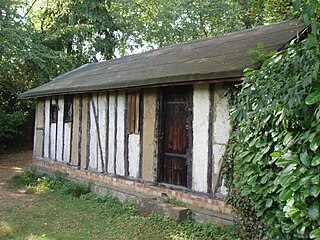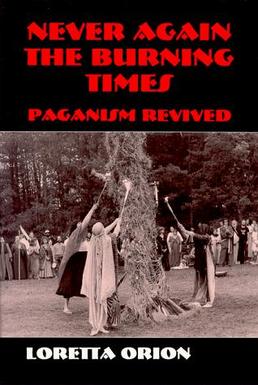The Charge of the Goddess is an inspirational text often used in the neopagan religion of Wicca. The Charge of the Goddess is recited during most rituals in which the Wiccan priest/priestess is expected to represent, and/or embody, the Goddess within the sacred circle, and is often spoken by the High Priest/Priestess after the ritual of Drawing Down the Moon.

Gardnerian Wicca, or Gardnerian witchcraft, is a tradition in the neopagan religion of Wicca, whose members can trace initiatory descent from Gerald Gardner. The tradition is itself named after Gardner (1884–1964), a British civil servant and amateur scholar of magic. The term "Gardnerian" was probably coined by the founder of Cochranian Witchcraft, Robert Cochrane in the 1950s or 60s, who himself left that tradition to found his own.

Wicca, also known as "The Craft", is a modern pagan, syncretic, earth-centered religion. Scholars of religion categorize it as both a new religious movement and as part of occultist Western esotericism. It was developed in England during the first half of the 20th century and was introduced to the public in 1954 by Gerald Gardner, a retired British civil servant. Wicca draws upon a diverse set of ancient pagan and 20th-century hermetic motifs for its theological structure and ritual practices.

A Book of Shadows is a book containing religious text and instructions for magical rituals found within the Neopagan religion of Wicca. Since its conception, it has made its way into many pagan practices and paths. The most famous Book of Shadows was created by the pioneering Wiccan Gerald Gardner sometime in the late 1940s or early 1950s, and which he utilised first in his Bricket Wood coven and then in other covens which he founded in following decades. The Book of Shadows is also used by other Wiccan traditions, such as Alexandrian Wicca and Mohsianism, and with the rise of books teaching people how to begin following non-initiatory Wicca in the 1970s onward, the idea of the Book of Shadows was then further propagated amongst solitary practitioners unconnected to earlier, initiatory traditions.
Alexandrian Wicca or Alexandrian Witchcraft is a tradition of the Neopagan religion of Wicca, founded by Alex Sanders who, with his wife Maxine Sanders, established the tradition in the United Kingdom in the 1960s. Alexandrian Wicca is similar in many ways to Gardnerian Wicca, and receives regular mention in books on Wicca as one of the religion's most widely recognized traditions.

Doreen Edith Dominy Valiente was an English Wiccan who was responsible for writing much of the early religious liturgy within the tradition of Gardnerian Wicca. An author and poet, she also published five books dealing with Wicca and related esoteric subjects.
Raymond Buckland, whose craft name was Robat, was an English writer on the subject of Wicca and the occult, and a significant figure in the history of Wicca, of which he was a high priest in both the Gardnerian and Seax-Wica traditions.

Blue Star Wicca is one of a number of Wiccan traditions, and was created in the United States in the 1970s based loosely on the Gardnerian and Alexandrian traditions.
Drawing down the Moon is a central ritual in many contemporary Wiccan traditions. During the ritual, a coven's High Priestess enters a trance and requests that the Goddess or Triple Goddess, symbolized by the Moon, enter her body and speak through her. The High Priestess may be aided by the High Priest, who invokes the spirit of the Goddess. During her trance, the Goddess is supposed to speak through the High Priestess.
The history of Wicca documents the rise of the Neopagan religion of Wicca and related witchcraft-based Neopagan religions. Wicca originated in the early 20th century, when it developed amongst secretive covens in England who were basing their religious beliefs and practices upon what they read of the historical witch-cult in the works of such writers as Margaret Murray. It also is based on the beliefs from the magic that Gerald Gardner saw when he was in India. It was subsequently founded in the 1950s by Gardner, who claimed to have been initiated into the Craft – as Wicca is often known – by the New Forest coven in 1939. Gardner's form of Wicca, the Gardnerian tradition, was spread by both him and his followers like the High Priestesses Doreen Valiente, Patricia Crowther and Eleanor Bone into other parts of the British Isles, and also into other, predominantly English-speaking, countries across the world. In the 1960s, new figures arose in Britain who popularized their own forms of the religion, including Robert Cochrane, Sybil Leek and Alex Sanders, and organizations began to be formed to propagate it, such as the Witchcraft Research Association. It was during this decade that the faith was transported to the United States, where it was further adapted into new traditions such as Feri, 1734 and Dianic Wicca in the ensuing decades, and where organizations such as the Covenant of the Goddess were formed.

In the neopagan religion of Wicca a range of magical tools are used in ritual practice. Each of these tools has different uses and associations and are commonly used at an altar, inside a magic circle.

Neopagan witchcraft, sometimes referred to as The Craft, is an umbrella term for some neo-pagan traditions that include the attempted practice of magic. These traditions began in the mid-20th century, and many were influenced by the witch-cult hypothesis; a now-rejected theory that persecuted witches in Europe had actually been followers of a surviving pagan religion. The largest and most influential of these movements was Wicca. Some other groups and movements describe themselves as "Traditional Witchcraft" to distinguish themselves from Wicca.

The Bricket Wood coven, or Hertfordshire coven is a coven of Gardnerian witches founded in the 1940s by Gerald Gardner. It is notable for being the first coven in the Gardnerian line, though having its supposed origins in the pre-Gardnerian New Forest coven. The coven formed after Gardner bought a plot at the Fiveacres Country Club, a naturist club in the village of Bricket Wood, Hertfordshire, southern England, and met within the club's grounds. It played a significant part in the history of the neopagan religion of Wicca.

Raymond Howard was an English practitioner of the modern Pagan new religious movement of Wicca. He promoted his tradition, known as the Coven of Atho, through a correspondence course established in the early part of the 1960s.
In Modern English, the term Wicca refers to Wicca, the religion of contemporary Pagan witchcraft. It is used within the Pagan community under competing definitions. One refers to the entirety of the Pagan Witchcraft movement, while the other refers explicitly to traditions included in what is now called British Traditional Wicca.

Enchanted Feminism: The Reclaiming Witches of San Francisco is an anthropological study of the Reclaiming Wiccan community of San Francisco. It was written by the Scandinavian theologian Jone Salomonsen of the California State University, Northridge and first published in 2002 by the Routledge.

Never Again the Burning Times: Paganism Revisited is an anthropological study of the Wiccan and wider Pagan community in the United States. It was written by the American anthropologist Loretta Orion and published by Waveland Press in 1995.

Living Witchcraft: A Contemporary American Coven is a sociological study of an American coven of Wiccans who operated in Atlanta, Georgia during the early 1990s. It was co-written by the sociologist Allen Scarboro, psychologist Nancy Campbell and literary critic Shirley Stave and first published by Praeger in 1994. Although largely sociological, the study was interdisciplinary, and included both insider and outsider perspectives into the coven; Stave was an initiate and a practicing Wiccan while Scarboro and Campbell remained non-initiates throughout the course of their research.

Edmund "Eddie" Buczynski was a prominent American Wiccan and archaeologist who founded two separate traditions of Wicca: Welsh Traditionalist Witchcraft and The Minoan Brotherhood.
Heather Denise Botting, née Harden, also known as Lady Aurora, born 21 September 1948, is a professor of anthropology at the University of Victoria in British Columbia. The original high priestess of Coven Celeste, she is a founding elder of the Canadian Aquarian Tabernacle Church and was the first recognized Wiccan chaplain in a public university.












